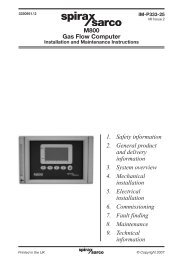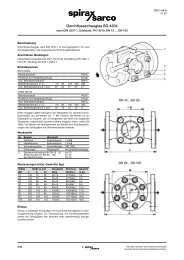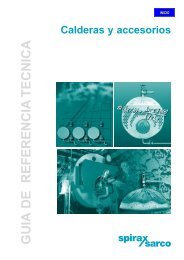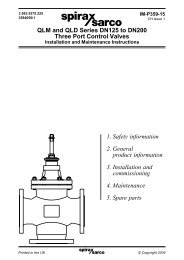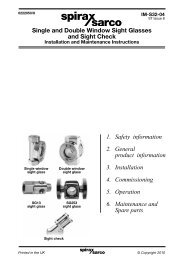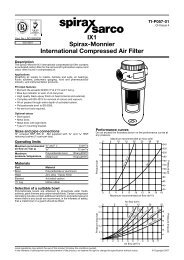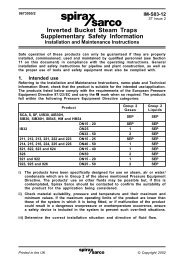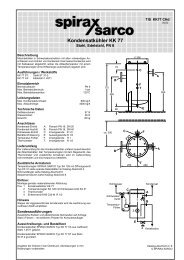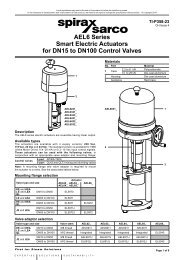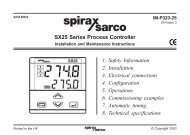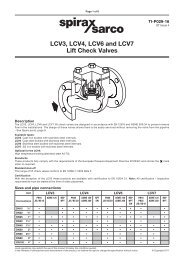2000 Hook-up Book - Spirax Sarco
2000 Hook-up Book - Spirax Sarco
2000 Hook-up Book - Spirax Sarco
You also want an ePaper? Increase the reach of your titles
YUMPU automatically turns print PDFs into web optimized ePapers that Google loves.
SYSTEM DESIGN<br />
62<br />
Compressed Air Systems<br />
Air Compressors<br />
Heat is released when air or any<br />
gas is compressed. The compressor<br />
must be cooled to avoid<br />
overheating, usually by circuating<br />
water through the jackets.<br />
Cooling is an important function<br />
which must be controlled to<br />
ensure maximum efficiency.<br />
Overcooling wastes water and<br />
leads to condensation within the<br />
cylinders, with deterioration of the<br />
lubricating oils. Undercooling<br />
reduces compressor capacity<br />
and can result in serious damage<br />
to the compressor. Automatic<br />
temperature control of cooling<br />
water flow ensures maximum efficiency.<br />
The atmosphere is a mixture<br />
of air and water vapor. Free air<br />
has a greater volume, and moisture<br />
holding capacity, than<br />
compressed air at the same temperature.<br />
As the compressed air<br />
is cooled after leaving the compressor,<br />
or between stages,<br />
some of the water is precipitated.<br />
This water must be drained from<br />
the system to avoid damage to<br />
pneumatic valves and tools.<br />
Choice Of Drainer Trap<br />
The quantities of water which<br />
must be drained from the air are<br />
relatively small, even on quite<br />
large installations, providing they<br />
are dealt with continuously. It is<br />
unusual to need air traps in sizes<br />
larger than 1/2". Except where a<br />
worn compressor is allowing<br />
lubricating oils to be discharged<br />
with the compressed air, float<br />
operated drainers are the best<br />
choice.<br />
Where the presence in the<br />
system of water/oil emulsions<br />
interferes with the operation of float<br />
drainers, the thermodynamic TD<br />
trap is used. As the TD trap needs<br />
an operating pressure of at least<br />
50 psi when used as an air drainer,<br />
care must be taken when it is used<br />
on small systems. Preferably, the<br />
TD’s should be valved off at start<strong>up</strong><br />
until the system pressure is <strong>up</strong><br />
to 50 psi or more.<br />
Sizing Compressed Air Traps<br />
The amount of water which is to be discharged is determined from<br />
steam table saturated vapor density or estimated with the help of a<br />
graph, Fig. 63 and compression ratio table. An example shows how this<br />
is used.<br />
Example:<br />
How much water will precipitate from 150 cfm of free air at 70°F and 90%<br />
relative humidity when compressed to 100 psig and cooled to 80°F?<br />
Air flow = 150 cfm X 60 = 9000 cu. ft/hour.<br />
From Fig. 63, at 70°F water in air drawn in will be<br />
1.15 X 9000 X 90% = 9.32 lb/h<br />
1000<br />
Determine excess moisture due to compression by dividing hourly air<br />
flow by factor from Compession Ratio Table 20B (page 64), and convert<br />
for (absolute) temperature.<br />
Compression ratio at 100 psig = 7.8<br />
Air volume after compression = 9000 X (460 + 80) = 1175 cu. ft./h<br />
7.8 (460 + 70)<br />
From Fig. 63, 1000 cu. ft. at 80°F can carry 1.6 lb. of water.<br />
1175 cu. ft. will carry 1175 X 1.6 = 1.88 lb/h<br />
1000<br />
So, (9.32 lb. – 1.88 lb.) = 7.44 lb/h of water will separate out.<br />
Figure 63: Moisture Holding Capacity of Air at Varying Temperatures<br />
Pounds Water Vapor per 1,000 cubic ft. at Saturation<br />
3.0<br />
2.8<br />
2.6<br />
2.4<br />
2.2<br />
2.0<br />
1.8<br />
1.6<br />
1.4<br />
1.2<br />
1.0<br />
.8<br />
.6<br />
.4<br />
.2<br />
0<br />
-20 -10 0 10 20 30 40 50<br />
Air Temp °F<br />
60 70 80 90 100



